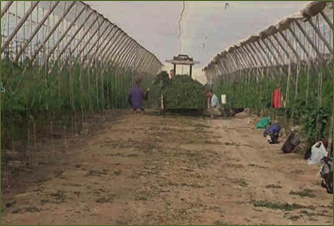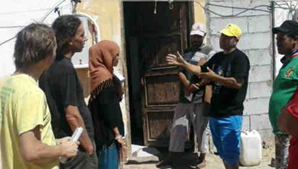Living (out of sight) under Plastic
The Community of Campohermoso
 Last December, REVISTA 21 published an article about migrants in the Níjar district where we live. Since we would find it difficult to improve on the description of the situation given there, we decided to copy some parts of the article written by Silvia Melero Abascal. In the article she touches on problems such as substandard living conditions, the exploitation of workers, the situation of the migrant woman, racism, schooling problems, non-integration etc…
Last December, REVISTA 21 published an article about migrants in the Níjar district where we live. Since we would find it difficult to improve on the description of the situation given there, we decided to copy some parts of the article written by Silvia Melero Abascal. In the article she touches on problems such as substandard living conditions, the exploitation of workers, the situation of the migrant woman, racism, schooling problems, non-integration etc…
In Spain, slave labour is allowed. There are workers living in substandard housing without water or electricity. They are almost invisible. They spend their lives under plastic. They work in plastic greenhouses and live in plastic huts. They provide the cheap labour which underpins the agricultural economy of the area.
These are migrant workers – both men and women – who live in various settlements in Almería (El Ejido, Roquetas, Níjar). It is difficult to know how many of them there are. In Níjar alone, there are over 60 settlements housing between 3,000 and 4,000 people.
 A settlement is a substandard housing estate consisting of plastic huts or small buildings. These settlements are constructed on farmland and the migrant population who work in the plastic greenhouses live there. It is thought that a new settlement appears every two or three months but nobody knows the exact number.
A settlement is a substandard housing estate consisting of plastic huts or small buildings. These settlements are constructed on farmland and the migrant population who work in the plastic greenhouses live there. It is thought that a new settlement appears every two or three months but nobody knows the exact number.
The people risk their lives trying to get such basic things as water and electricity. They sometimes travel three or four kilometres by bicycle to fill their water containers from a public tap. Sometimes they get the water from the greenhouse owner’s supply. Last year a boy was electrocuted trying to get a connection from an electrical cable.
Some people work eight hours a day for a daily wage of 30 Euro and sometimes they have to work for fourteen hours a day. At other times there is no work at all. In the Summer they have to work under plastic in temperatures of over 50ºC; that is those who manage to get work because obviously there is not enough work for so many people.
When the settlements were begun, they were occupied by men but this situation has changed. Now families with young children are living there in unsafe conditions. The people are mainly sub-Saharan or Moroccan with some Roma people from Eastern Europe.
The first women came to the Almerian settlements to work in the strawberry beds. Without a work permit they are condemned to be dependent on their husbands and are very vulnerable. “Without documents, we cannot work and without work we cannot get documents. So, how are we supposed to live?”
A 2014 report from the Simetrías Foundation said that “the young people who live there are exposed to dangerous social and sanitary conditions as a result of living in precarious situations”. They have problems with health, education, language and integration and could end up being another “lost generation” The children have to walk up to 40 minutes to school and if it rains or is windy they cannot go.
In the 90s there was a great demand for labour in Almerían agriculture and the sector benefitted and still benefits from this cheap labour. This model based on a high return from intensive farming has a high production level for both domestic consumption and for export. Everyone has always known that this work depends on migrants, the majority of whom have no work contracts.
Eva Moreno is the co-ordinator of the Cepaim Centre in Níjar. “After the Paris attack, the Moslem migrants are picked on and are victims of xenophobia. The bit of progress that was made in the past few years is lost in a second when something like that happens and all the people are tarred with the same brush. The future is interculturality and we have that here in our society. Our society is mixed and that is an enrichment. There is nothing better than to be open to others and get to know them. They are not enemies and they have not come to deprive us of anything. They are fleeing from very serious problems in their countries of origin and are doing very important work here. They are not in any way aggressive people. They work hard. For years they have been the ones who have kept agriculture going in Almería.”
Organisations like Cepaim, The Red Cross, Doctors of the World, Caritas and the Mercy Sisters of Charity try to help them but the situation of many families is very complex.
Those are some extracts from the article. If you have the opportunity, we invite you to read the whole article by Silvia Melero Abascal in REVISTA 21
We know that everything in the article is true but we also know that there is another side to the story. There are many greenhouse owners who treat their employees as members of their own family; thousands of migrants – the majority – live in houses or apartments even though sometimes eight or ten people live in one apartment. It is also true that many of the migrants prefer to live in the settlements where they do not have to pay for rent, water or electricity and can save the money to send to their families. Many, mostly Moroccans, have a car, a house and their own business.
As you can imagine, the community can do very little in the face of such great need. We help Caritas in giving out food. We give Spanish classes and we collaborate in the Occupational Workshops which the Mercy Sisters of Charity run in San Isidro. Above all, we try to listen to the people, welcome them and be with them. It is often said – but it is really true – that they give us much more than we give them. Their joy in spite of their difficulties, their hope, their desire to improve their family’s situation back home, the way they support one another help us to believe that, in spite of everything, “The reign of God is among us.”
